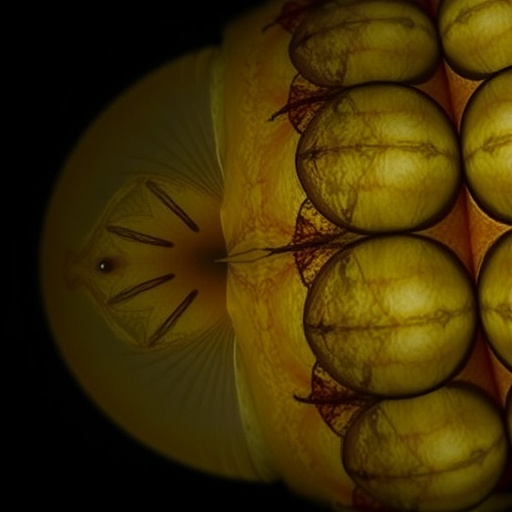In the intricate web of aquatic ecosystems, understanding the anatomy and behavior of various species provides profound insights into their ecological roles and evolutionary adaptations. A recent study focused on the otolith morphology of the mudskipper, specifically the species Periophthalmodon schlosseri, sheds light on the relationships between otolith characteristics and body size in these fascinating creatures. Conducted in the Bac Lieu province of Vietnam, this research offers a fresh perspective on how anatomical features can unveil information about the adaptability of mudskippers to their unique environments.
Otoliths, or ear stones, are small structures found in the inner ear of fish that serve essential roles in sensing movement and orientation. They are composed of calcium carbonate and are pivotal for balance and hearing. In the mudskipper, these structures play an even more crucial role due to the fish’s amphibious lifestyle, allowing it to navigate between aquatic and terrestrial habitats. The morphological variations in otoliths can provide crucial insights into the species’ behavior and adaptation strategies in fluctuating environments such as muddy intertidal zones.
The research meticulously examined the relationship between otolith size, shape, and the overall size of the body in Periophthalmodon schlosseri. This relationship is significant as it suggests that otolith development may be closely linked to growth patterns and environmental adaptations. By correlating otolith morphology with body size, researchers were able to establish baseline data that could enhance our understanding of these fish’s ecological strategies, particularly how they forage and evade predators in their challenging habitats.
Understanding the positional characteristics of otoliths is equally vital. In this study, otolith positioning was assessed in relation to other critical anatomical features. This positioning can influence the efficiency of the sensory system in detecting changes in the surrounding environment, proving invaluable for survival in both terrestrial and aquatic settings. Such insights can aid in deciphering how these fish interact with their environment, making them better equipped for their unique lifestyle.
The implications of this study extend beyond mere anatomical description; they touch upon the broader themes of biodiversity and adaptation. Periophthalmodon schlosseri serves as a remarkable example of how species can evolve distinct physiological traits that enable them to thrive in challenging conditions. This adaptability is particularly relevant in the context of climate change, where shifts in habitat conditions could pose significant risks to many aquatic organisms.
Moreover, the findings from Bac Lieu underscore the importance of preserving biodiversity and the habitats that support these unique species. As anthropogenic pressures continue to escalate in many ecosystems, understanding the mechanisms of adaptation becomes pivotal in conservation efforts. This study not only highlights the importance of otolith morphology as a tool for studying fish biology but also emphasizes the need for continued monitoring of ecosystem health.
Looking forward, future research could further explore the implications of otolith morphology in a wider range of fish species. Comparisons with other mudskipper species or even diverse aquatic organisms could provide a more comprehensive understanding of how such adaptations align within evolutionary frameworks. Such cross-species comparisons can elucidate whether similar environmental pressures yield analogous anatomical adaptations across different taxa.
Furthermore, further exploration into the genetic factors influencing otolith development could enrich our understanding of the developmental biology of these structures. As we delve into the genetic underpinnings of these adaptations, we open new avenues for research that may lead to breakthroughs in how we understand evolutionary processes in fish.
The interplay between ecological dynamics and morphological adaptations presents a captivating field of study, particularly in the context of a rapidly changing planet. The otolith research conducted in Bac Lieu adds a crucial piece to the puzzle of understanding how organisms like Periophthalmodon schlosseri can navigate the complexities of their environments. As we unravel more about these relationships, we enhance our capacity to predict how species might respond to future environmental challenges.
This research also highlights the broader implications of studying anatomical features in the context of fishery management and conservation. As fish populations face increasing pressures from overfishing and habitat degradation, understanding their biological characteristics becomes essential. Metrics derived from studies like this can equip stakeholders with vital data to make informed decisions aimed at preserving fish populations and their ecosystems.
In essence, the exploration of otolith morphology, position, and size-body relationships in Periophthalmodon schlosseri serves as a powerful testament to the intricate relationships that exist within aquatic environments. These findings enrich our understanding of not only the species in question but also the broader ecological narratives they represent. Ultimately, this research may inspire future conservation strategies, urging us to rethink how we approach the protection of biodiversity.
As we continue to explore the natural world, studies like this reinforce the importance of scientific inquiry in revealing the hidden connections that bind species to their environments. Observing how anatomical adaptations evolve in tandem with behavioral strategies opens up exciting pathways for understanding the resilience of life amidst change. The future of fish biology research is undoubtedly bright, promising new discoveries that will enhance our appreciation for the complexity of life beneath the surface.
To summarize, the research conducted on the otoliths of Periophthalmodon schlosseri offers crucial insights into the anatomical and ecological marvel of mudskippers. By examining the morphology, positioning, and relationships between otoliths and body size, this study lays a foundation for future inquiries into the biology of fish and their adaptations within their unique habitats. As we advance our understanding of these relationships, we not only gain clarity on the species itself but also cultivate a deeper respect for the delicate balance of our ecosystems.
Subject of Research: Otolith morphology, position, and size-body relationships in Periophthalmodon schlosseri
Article Title: Otolith morphology, position, and size-body relationships in Periophthalmodon schlosseri (Gobiiformes: Oxudercidae) from Bac Lieu, Vietnam
Article References: Tran, L.T., Quach, T.A., Le, Y.T. et al. Otolith morphology, position, and size-body relationships in Periophthalmodon schlosseri (Gobiiformes: Oxudercidae) from Bac Lieu, Vietnam. Discov Anim 2, 72 (2025). https://doi.org/10.1007/s44338-025-00123-5
Image Credits: AI Generated
DOI: 10.1007/s44338-025-00123-5
Keywords: Otolith morphology, Periophthalmodon schlosseri, biodiversity, adaptation, ecology, Vietnam




